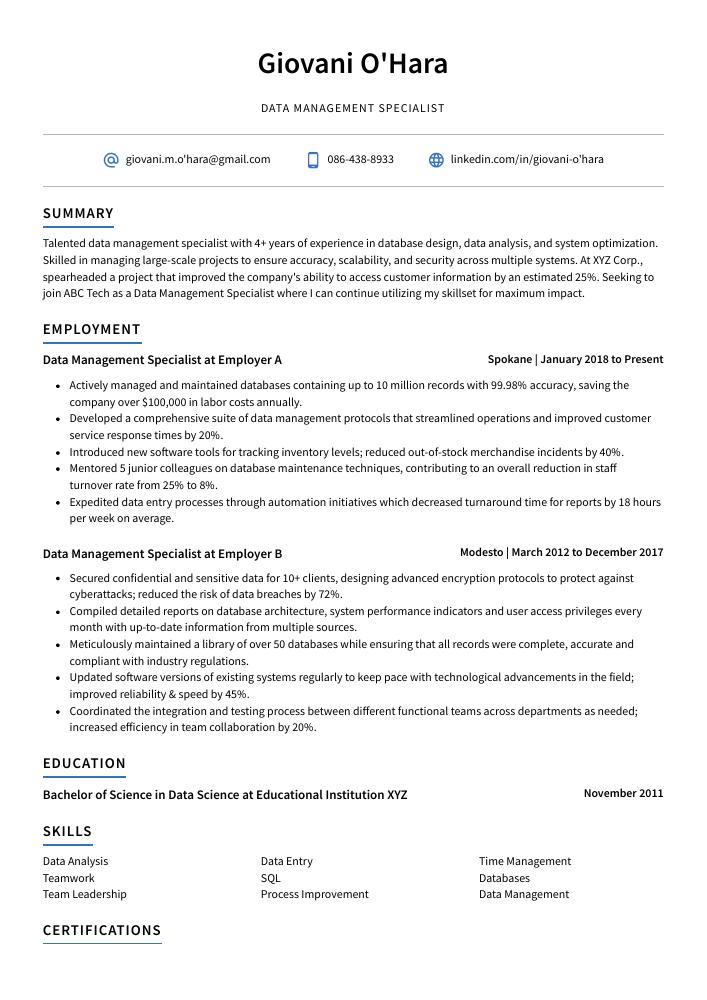Data Management Specialist Resume Guide
Data management specialists work to maintain and organize large amounts of data. They develop strategies for storing, manipulating, analyzing, and visualizing data in order to improve business operations. Data management specialists also ensure the accuracy of databases by regularly auditing them for quality control purposes.
Data management is your forte, but employers won’t know that unless you tell them. To make sure they take notice of your skills and experience, you must write a resume highlighting why you’re the perfect candidate for their team.
This guide will walk you through the entire process of creating a top-notch resume. We first show you a complete example and then break down what each resume section should look like.
Table of Contents
The guide is divided into sections for your convenience. You can read it from beginning to end or use the table of contents below to jump to a specific part.
Data Management Specialist Resume Sample
Giovani O’Hara
Data Management Specialist
giovani.m.o’[email protected]
086-438-8933
linkedin.com/in/giovani-o’hara
Summary
Talented data management specialist with 4+ years of experience in database design, data analysis, and system optimization. Skilled in managing large-scale projects to ensure accuracy, scalability, and security across multiple systems. At XYZ Corp., spearheaded a project that improved the company’s ability to access customer information by an estimated 25%. Seeking to join ABC Tech as a Data Management Specialist where I can continue utilizing my skillset for maximum impact.
Experience
Data Management Specialist, Employer A
Spokane, Jan 2018 – Present
- Actively managed and maintained databases containing up to 10 million records with 99.98% accuracy, saving the company over $100,000 in labor costs annually.
- Developed a comprehensive suite of data management protocols that streamlined operations and improved customer service response times by 20%.
- Introduced new software tools for tracking inventory levels; reduced out-of-stock merchandise incidents by 40%.
- Mentored 5 junior colleagues on database maintenance techniques, contributing to an overall reduction in staff turnover rate from 25% to 8%.
- Expedited data entry processes through automation initiatives which decreased turnaround time for reports by 18 hours per week on average.
Data Management Specialist, Employer B
Modesto, Mar 2012 – Dec 2017
- Secured confidential and sensitive data for 10+ clients, designing advanced encryption protocols to protect against cyberattacks; reduced the risk of data breaches by 72%.
- Compiled detailed reports on database architecture, system performance indicators and user access privileges every month with up-to-date information from multiple sources.
- Meticulously maintained a library of over 50 databases while ensuring that all records were complete, accurate and compliant with industry regulations.
- Updated software versions of existing systems regularly to keep pace with technological advancements in the field; improved reliability & speed by 45%.
- Coordinated the integration and testing process between different functional teams across departments as needed; increased efficiency in team collaboration by 20%.
Skills
- Data Analysis
- Data Entry
- Time Management
- Teamwork
- SQL
- Databases
- Team Leadership
- Process Improvement
- Data Management
Education
Bachelor of Science in Data Science
Educational Institution XYZ
Nov 2011
Certifications
Certified Data Management Professional
Data Management Association International
May 2017
1. Summary / Objective
Your resume summary/objective should be a brief but powerful statement that captures the essence of who you are as a data management specialist. In this section, you can highlight your expertise in database design and development, your experience with analytics tools such as Tableau or Power BI, and any certifications related to data security or privacy. You could also mention how you have successfully managed large-scale projects in the past.
Below are some resume summary examples:
Accomplished data management specialist with a track record of success in developing innovative solutions for data storage and retrieval. Experienced in using various database software to create, manage, and maintain databases for large organizations. Highly adept at ensuring the accuracy and security of complex data systems through proactive monitoring and analysis. Proven ability to troubleshoot problems quickly while maintaining an excellent customer service experience.
Skilled data management specialist with 8+ years of experience in data analysis, reporting, and manipulation. Experienced in leveraging SQL to build and maintain databases for clients from diverse industries. Highly knowledgeable about creating custom solutions for complex information systems that meet customer requirements. Seeking to join ABC Company as a Data Management Specialist and use my expertise to optimize data processes within the organization.
Hard-working data management specialist with 5+ years of experience in database administration and analytics. Experienced in creating, managing, and analyzing large datasets to identify trends, correlations, and outliers. At XYZ Corporation led a project that resulted in increased efficiency by 30% while reducing costs by 15%. Skilled at using data visualization tools such as Tableau to present findings clearly for stakeholders.
Determined data management specialist with 5+ years of experience developing, implementing, and managing data systems for large-scale projects. Adept at utilizing databases to identify trends in financial information and improve efficiency. At XYZ Corportaion, developed a data organization system that improved accuracy by 30%. Received multiple awards from the company for going above expectations on every project assigned.
Diligent data management specialist with 5+ years of experience in managing large datasets and developing databases for various organizations. Skilled at analyzing data to identify trends, patterns, discrepancies, and areas of improvement. At XYZ Company, implemented an automated system that significantly reduced manual labor by 80%. Adept at using SQL queries to create reports and insights into customer behavior.
Seasoned data management specialist with 8+ years of experience developing and implementing data-driven solutions. Expertise in designing, deploying, and maintaining database systems used to store critical business information. Proven success creating custom databases that increase efficiency by 14%. Passionate about joining ABC Company’s team to streamline the data analysis process for their clients.
Detail-oriented data management specialist with 8+ years of experience in analyzing, manipulating, and transforming large datasets. Possessing a deep understanding of data warehousing principles, database design best practices, and ETL processes. Recent success includes leading the migration of Company X’s entire sales dataset to an entirely new platform without any disruption to operations.
Driven data management specialist with 5+ years of experience in data analysis and manipulation. Eager to join ABC Technologies to use expertise in software engineering, database development, and project management tools for developing innovative solutions that meet customer demands. At XYZ Company, identified a critical flaw in the internal network architecture which reduced costs by 15%.
2. Experience / Employment
Next comes the work history section, which should be written in reverse chronological order, with your most recent job listed first. Stick to bullet points primarily; this will make it easier for the reader to digest what you have to say quickly and efficiently.
When writing these bullets, you want to provide detail on what you did and the results achieved. For example, instead of saying “Created reports,” try something like “Developed detailed monthly financial reports that enabled senior management team members to identify cost savings opportunities.”
To write effective bullet points, begin with a strong verb or adverb. Industry specific verbs to use are:
- Analyzed
- Collected
- Processed
- Managed
- Stored
- Structured
- Monitored
- Updated
- Implemented
- Optimized
- Automated
- Secured
- Documented
- Visualized
Other general verbs you can use are:
- Achieved
- Advised
- Assessed
- Compiled
- Coordinated
- Demonstrated
- Developed
- Expedited
- Facilitated
- Formulated
- Improved
- Introduced
- Mentored
- Participated
- Prepared
- Presented
- Reduced
- Reorganized
- Represented
- Revised
- Spearheaded
- Streamlined
- Utilized
Below are some example bullet points:
- Monitored, tracked and analyzed data from multiple sources to identify trends, uncover areas of improvement and optimize organizational processes; increased efficiency by 20%.
- Formulated detailed reports based on gathered information that accurately depicted the current status of company operations; enabled stakeholders to make informed decisions resulting in a $6,000 cost savings.
- Accurately managed large databases using SQL queries ensuring consistent accuracy across all records; improved query speed time by an average of 3 seconds per request.
- Visualized complex datasets through graphical presentations utilizing Tableau software which helped management interpret results quickly and easily leading to more effective decision-making strategies for the organization as a whole.
- Represented key findings during meetings with executives, illustrating insights gained from various analytics projects in order to drive business outcomes that resulted in sales growth of 15%.
- Managed the organization’s data architecture, effectively organizing and storing over 20 terabytes of information in an easily-accessed system; reduced time spent on locating vital files by 30%.
- Participated actively in the implementation of new software systems for data entry and retrieval, streamlining the process to improve efficiency by 25%.
- Reliably maintained databases through regular backups and updates; prevented potential risks from occurring with a 99% success rate.
- Structured complex datasets into organized tables & charts according to customer requirements; successfully designed customized reports that enabled decision making within 2 days after project initiation.
- Achieved 95% accuracy when verifying records against other sources as part of quality assurance processes; identified discrepancies between documents/data entries which resulted in improved overall performance metrics across departments by 15%.
- Demonstrated advanced knowledge of data management tools and techniques to identify, analyze, manage and organize large volumes of data across multiple systems; increased database efficiency by 25%.
- Utilized SQL queries to cleanse, sort and extract information from existing databases for reporting purposes; generated over 500 weekly reports with 95% accuracy in less than 4 hours per report.
- Facilitated daily backups on the company’s internal server while monitoring its performance levels closely to ensure smooth operations at all times.
- Analyzed trends in customer responses using advanced analytics software such as Tableau & Excel Power Pivot; identified new market opportunities worth an estimated $500K annually for the organization’s growth strategy plans.
- Confidently worked under pressure without compromising quality or timelines when managing urgent requests within strict deadlines; successfully completed 10+ projects ahead of schedule with zero errors reported during QA process evaluation phases.
- Optimized data management processes and systems, resulting in a 20% increase in data storage capacity.
- Advised senior leadership on best practices for database maintenance and security; successfully implemented new policies that improved overall system performance by 10%.
- Spearheaded the development of an automated reporting system for tracking customer information, reducing manual labor time by 25 hours per week and increasing accuracy of records by 30%.
- Stored sensitive customer data securely to ensure compliance with GDPR regulations; eliminated potential risks associated with unauthorized access or misuse of personal data from external sources.
- Efficiently managed over 500GB worth of company databases using MySQL, MongoDB & Oracle SQL tools; reduced query response times from 5 minutes to 1 minute on average while maintaining reliable server uptime at all times.
- Assessed and evaluated current data management systems to identify areas of improvement, implementing new processes that substantially reduced errors and improved data accuracy by 25%.
- Processed, analyzed and organized large volumes of customer information into a secure database; managed over 78 million records with an average retrieval time of 2 minutes or less.
- Implemented several automated system tools for streamlining manual processes such as report generation and user authentication, saving up to 4 hours per day in administrative tasks.
- Substantially reduced server downtime from 8 times a month to 0 times through regular maintenance activities using SQL queries & RDBMS software like Oracle DB & MS Access.
- Reduced cost associated with IT support staff expenses by 40% through successful implementation of optimized backup protocols for disaster recovery scenarios.
- Effectively managed enterprise data for large-scale projects, leading to a 3% increase in accuracy and completeness of the databases.
- Improved existing reporting processes by introducing new technologies such as Python and SQL; reduced report preparation time from 2 hours to 15 minutes on average.
- Presented findings from analytics models delivered through Tableau or Power BI at weekly meetings with stakeholders, enabling them to make educated decisions about future business strategies.
- Streamlined daily operations within the team by implementing automated workflows using Salesforce tools; saved over 90 man-hours per month in manual labor costs across all departments involved.
- Automated end-to-end testing processes to ensure that all newly developed software functions met project requirements, resulting in an overall reduction of defects found during deployment stages by 25%.
- Revised and maintained databases containing up to 10,000 records of customer information and sales data; increased accuracy by 35%.
- Reorganized existing filing systems in order to facilitate retrieval and storage of data more efficiently; reduced search time for specific files by 50%.
- Prepared weekly reports on the performance of various marketing campaigns and delivered them on-time to management; improved decision-making process by 25%.
- Collected quantitative market research from multiple sources and processed it into easily digestible insights that could be used for strategic planning purposes.
- Resourcefully identified potential technology upgrades needed within the company’s database system, reducing downtimes due to technical issues by 40 hours per month.
3. Skills
The skillset employers require in an employee will likely vary, either slightly or significantly; skimming through their job adverts is the best way to determine what each is looking for. One organization may need someone with experience in data analysis and another may require knowledge of database management systems.
It is essential to tailor the skills section of your resume for each job you are applying for, as many employers use applicant tracking systems (ATS) that scan resumes for certain keywords before passing them on to a human.
Once listed here, it is important to elaborate further on these skills by discussing them in more detail elsewhere – such as the summary or experience sections – so they stand out from other applicants.
Below is a list of common skills & terms:
- Access
- Analysis
- Business Analysis
- Business Intelligence
- Communication
- Data Analysis
- Data Entry
- Data Management
- Databases
- Microsoft SQL Server
- Nonprofits
- Process Improvement
- Program Management
- Project Planning
- Requirements Analysis
- SQL
- SharePoint
- Software Documentation
- Teaching
- Team Leadership
- Teamwork
- Time Management
- Troubleshooting
4. Education
Mentioning your education on your resume will depend on how far along you are in your career. If you have just graduated and do not have any prior experience, mention it below the objective section of your resume. However, if you already have significant work experience to showcase, omitting an education section is perfectly acceptable.
If including an education section is necessary for the data management specialist role you’re applying for, try to include courses and subjects related to data management that demonstrate a knowledge base relevant to the job position.
Bachelor of Science in Data Science
Educational Institution XYZ
Nov 2011
5. Certifications
Certifications are an important part of a resume as they demonstrate to employers that you have the necessary skills and knowledge for the job. Having certifications also shows that you are committed to staying up-to-date in your field and have taken steps to further develop yourself professionally.
Include any relevant certifications on your resume, especially if it is related directly or indirectly with the position you are applying for. This will make sure hiring managers know about all of your qualifications and can easily assess how well suited you are for their role.
Certified Data Management Professional
Data Management Association International
May 2017
6. Contact Info
Your name should be the first thing a reader sees when viewing your resume, so ensure its positioning is prominent. Your phone number should be written in the most commonly used format in your country/city/state, and your email address should be professional.
You can also choose to include a link to your LinkedIn profile, personal website, or other online platforms relevant to your industry.
Finally, name your resume file appropriately to help hiring managers; for Giovani O’Hara, this would be Giovani-O’Hara-resume.pdf or Giovani-O’Hara-resume.docx.
7. Cover Letter
Submitting a cover letter is a great way to make your job application stand out from the rest. It can be made up of 2 or 4 paragraphs and provides an opportunity for you to explain why you are the ideal candidate for the role.
Unlike resumes, cover letters give recruiters more insight about who you are as a professional and how your skillset makes you suitable for the job at hand. Even if it’s not required, writing one is highly recommended in order to maximize your chances of being selected for an interview.
Below is an example cover letter:
Dear Maci,
I am writing to apply for the position of Data Management Specialist at XYZ Corporation. With more than five years’ experience managing data in a corporate environment, I am confident I can be an asset to your team.
In my current role as Data Manager at ABC Corporation, I oversee a team of four data entry specialists and have been responsible for streamlining our data management processes. As a result of my efforts, we have cut our data entry error rate by 30%. In addition, I have developed several custom database applications that have improved our efficiency and productivity.
I am skilled in all major database software programs, including MySQL, Oracle, and SQL Server. In addition, I have experience working with Big Data platforms such as Hadoop and NoSQL databases. My strong technical skills combined with my ability to manage complex projects make me an ideal candidate for this position.
I would welcome the opportunity to discuss how I could use my skills and experience to benefit your organization. Please contact me at [phone number] or [email address] to arrange a meeting time that is convenient for you. Thank you for your time and consideration; I look forward to hearing from you soon!
Sincerely,
Giovani
Data Management Specialist Resume Templates
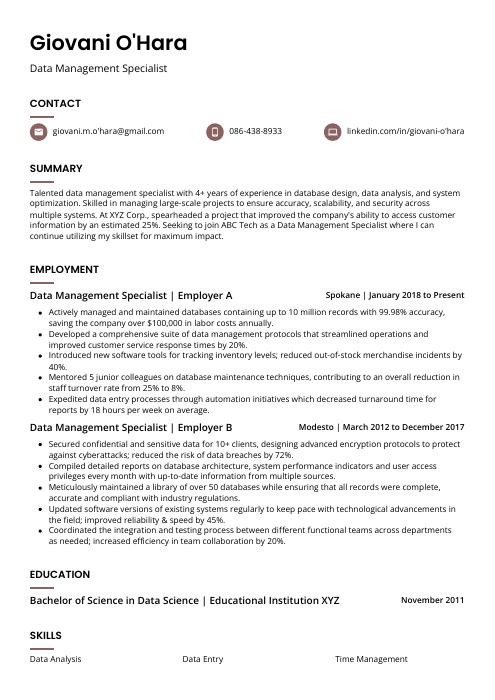 Fossa
Fossa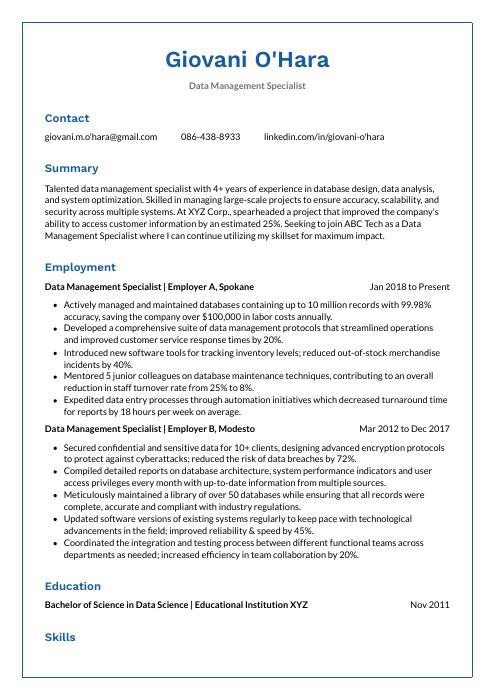 Markhor
Markhor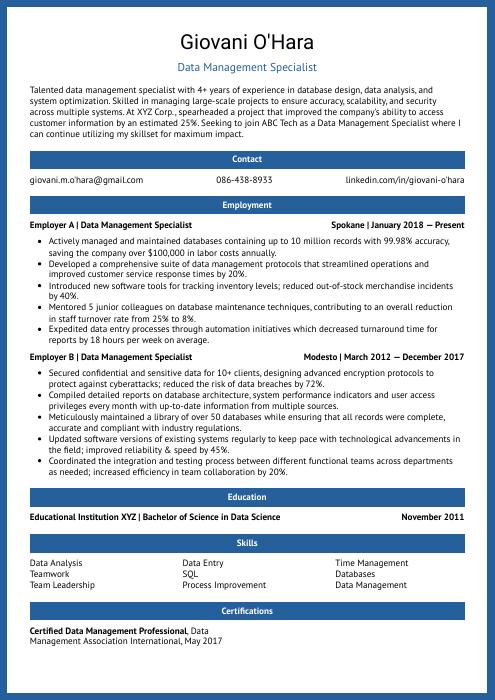 Ocelot
Ocelot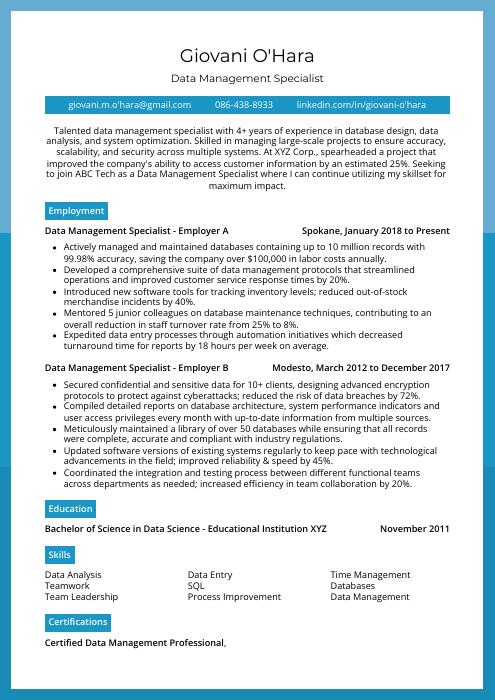 Rhea
Rhea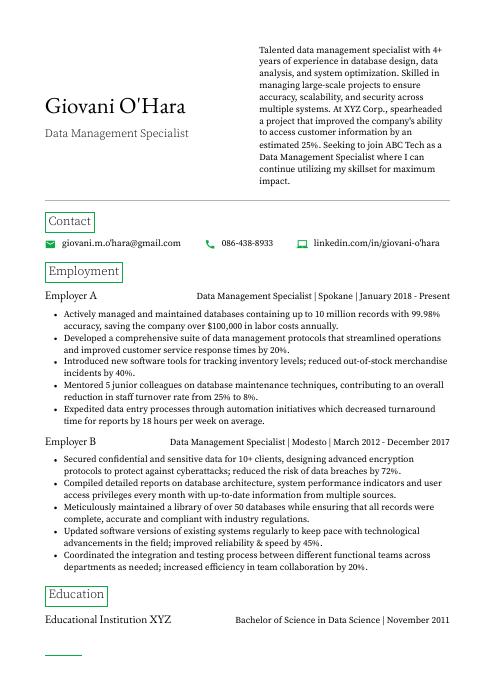 Quokka
Quokka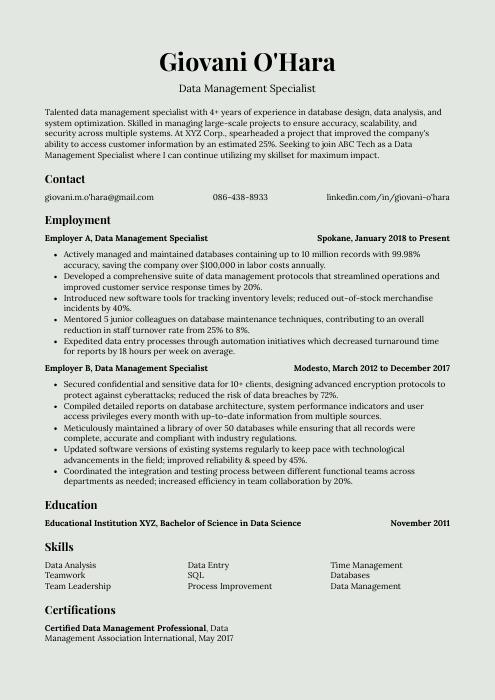 Saola
Saola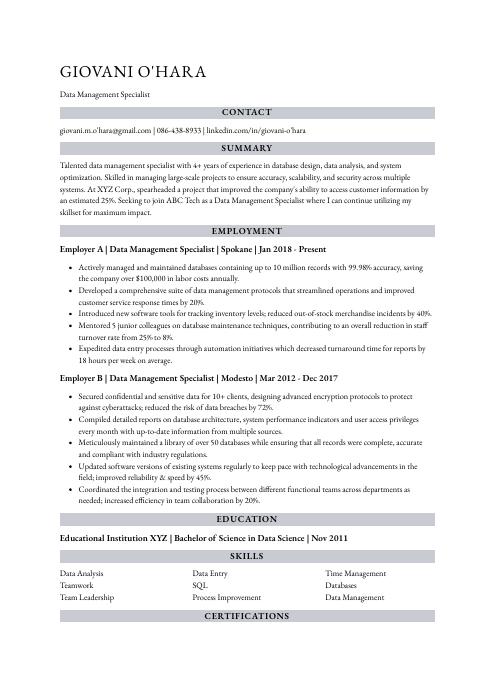 Numbat
Numbat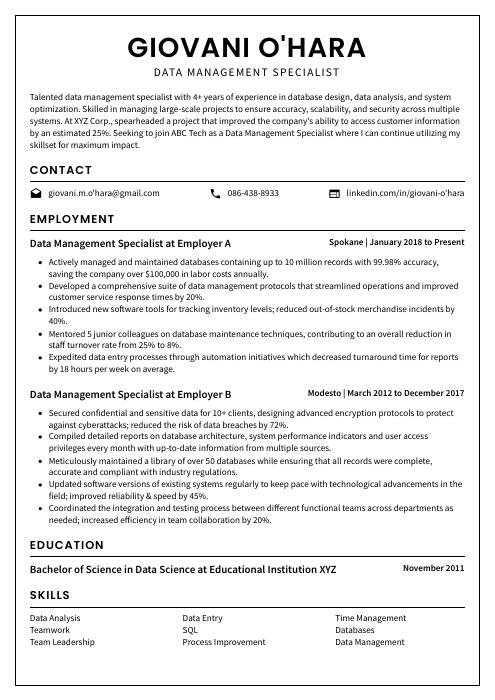 Cormorant
Cormorant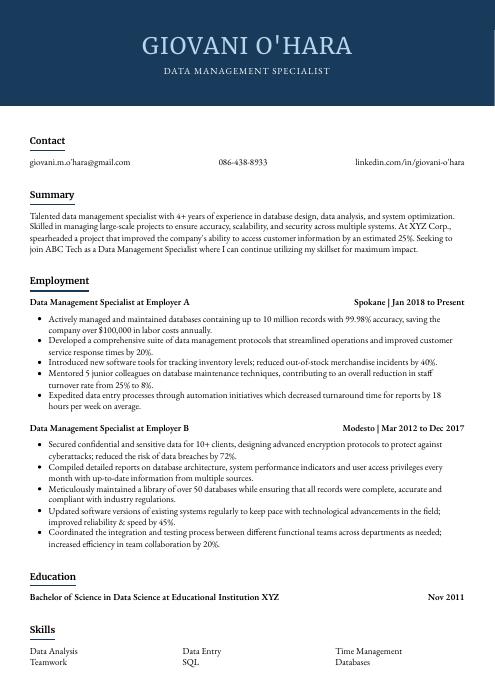 Bonobo
Bonobo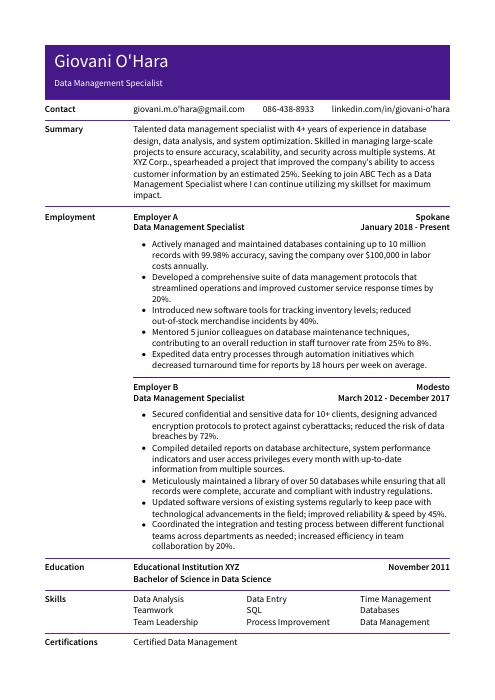 Pika
Pika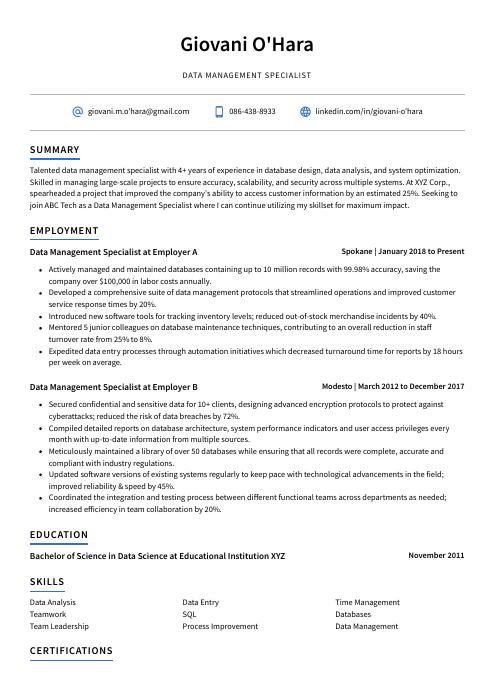 Axolotl
Axolotl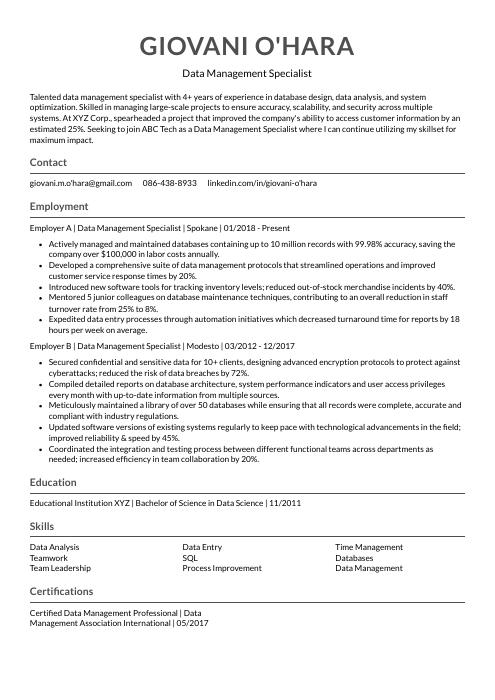 Indri
Indri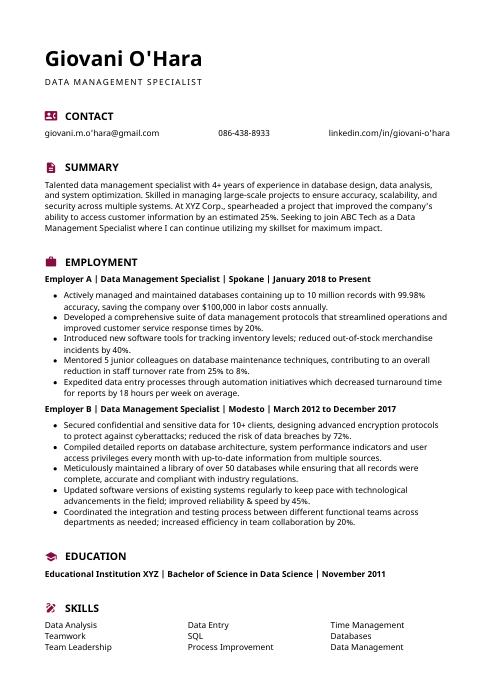 Hoopoe
Hoopoe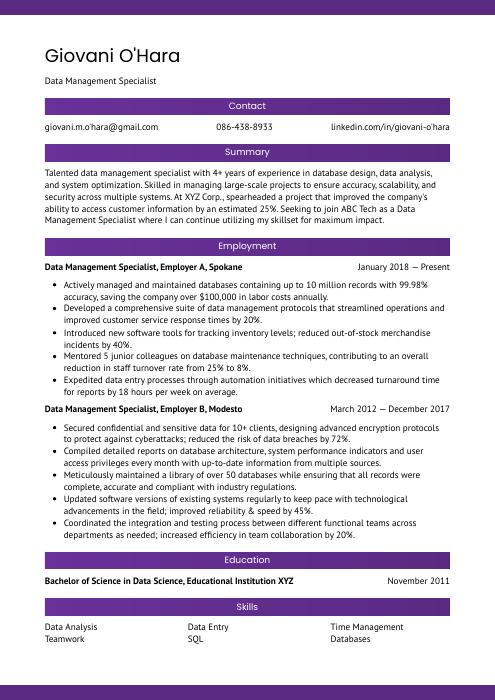 Jerboa
Jerboa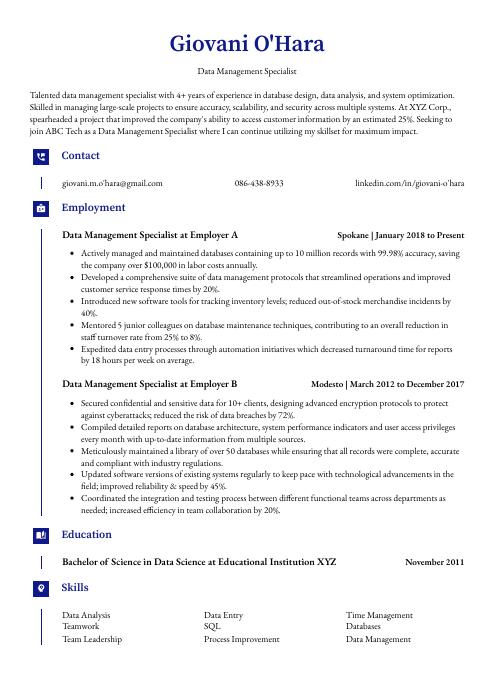 Gharial
Gharial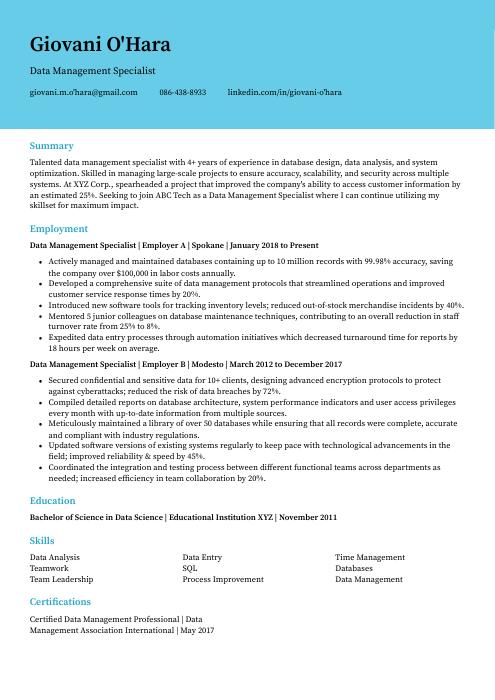 Dugong
Dugong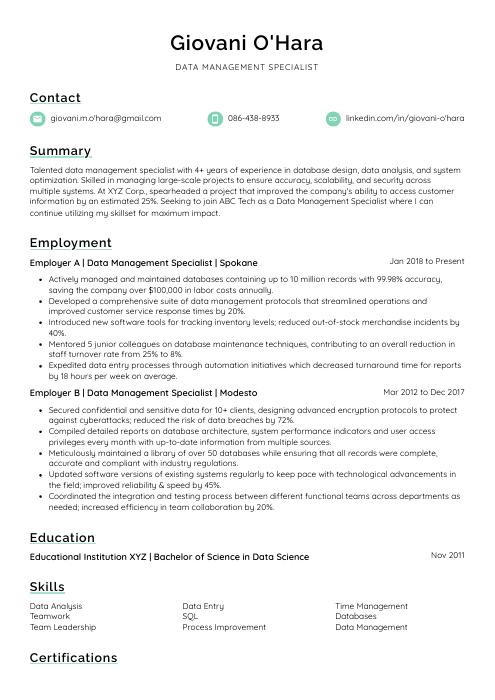 Lorikeet
Lorikeet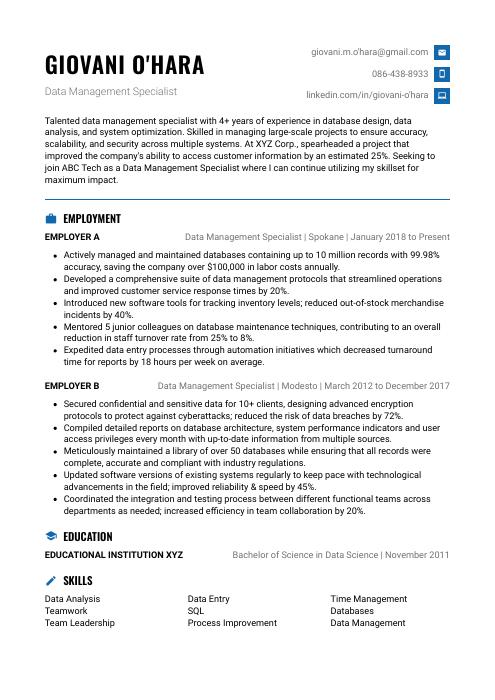 Echidna
Echidna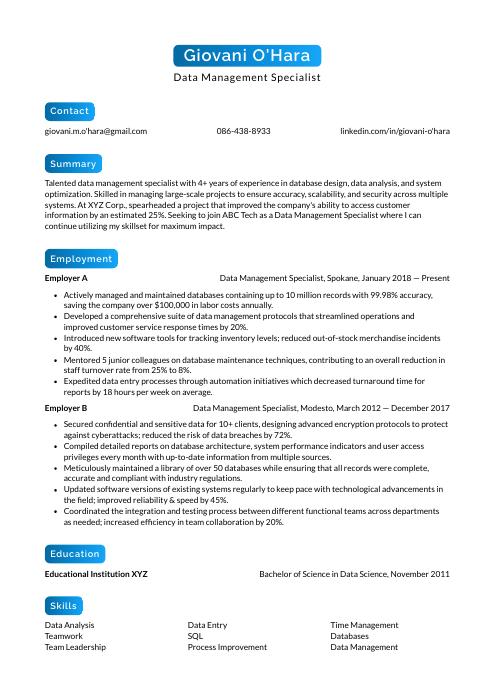 Kinkajou
Kinkajou Rezjumei
Rezjumei
